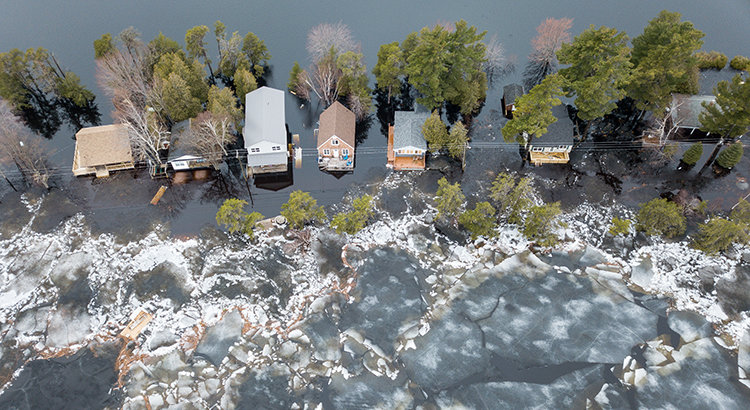
You can't watch TV or read the news without wondering with rising global temperatures what the impact of weather, storms and droughts can be expected and what the implications are for our homes.
Should I move?
According to a report by Realtor.com, 78% of buyers took incidences of natural disaster into account when choosing where to buy their home. Further, it reported that 34% of existing homeowners have considered selling their houses and moving to a new location because of the changing climate. While we do not need to go into the devastation of the fires in 2021, we know that many of our new transplants from Silicon Valley came here for a combination or reasons including the threat of fires and drought. You cannot completely remove your risk from a natural disaster anywhere you go, however there are ways to mitigate risk.
Should I buy?
The better a city is prepared for climate events, the easier it will be for life to return to relative normalcy after a climate event. In the past it was uncommon for us to hear questions from potential buyers regarding weather events but in the past couple of years we have begun to. In the north, you might be more acutely aware of the services for plowing snow, but as we enter into an era with more climate events, climate planning is critical for your long-term enjoyment of a home and location. Remember to consider the three questions below when home buying.
-
Does this city have a climate action plan?
-
Is the property I'm considering within a flood plain?
-
Does this home have features that will help it to withstand a major climate event?
Believe it or not, building on flood plains was not an uncommon practice. Your Realtor will understand the neighborhood and if you have doubts, there are some excellent resources for quickly discovering whether a property is likely to be impacted by flooding. Discovering potential impact from flooding is just one of the many reasons homebuyers should obtain a survey when buying a home.
neighborhood and if you have doubts, there are some excellent resources for quickly discovering whether a property is likely to be impacted by flooding. Discovering potential impact from flooding is just one of the many reasons homebuyers should obtain a survey when buying a home.
Sellers
If you're getting ready to sell your home you and/or your Realtor should check the latest FEMA maps and determine beforehand if your property is located within or adjacent to a designated flood plain. If it is you should proactively determine if flood insurance will be required by a lender as well as the cost for it so that you may disclose this information to a buyer right upfront. If a part of your land is within a known flood plain, don't freak out. It may be that the actual house is not. This is the purpose of an elevation survey which if it determines your home is actually above the flood plain. We have had several instances where our clients were able to get heavily discounted flood insurance by submitting an elevation survey to FEMA. In some instance all that was necessary was for them to have the AC compressor or heatpump located outside the house on a stand to get it above the flood plain elevation.
BUilding Features with climate Change in Mind
There are a number of things builders can incorporate when building a home that will help it to withstand future climate change. Below is a list of some of the more common, readily available ones.
- 2X6 sidewall framing. This is not only stronger and better able to withstand winds, but gives you 50% more sidewall insulation to help keep your home both warmer in the winter and cooler in the sumer
- Radiant Barrier in the roof - this product reflects heat and can keep your attic space 30-40 degrees cooler in the summer.
- Spray foam Insulation - this type of insulation doesn't lose it's insulating qualities over time and provides much better insulating quality.
- Lighter color shingles will reflect sunlight keeping your home cooler.
- Zip Panel Sheathing- Most builder use OSB (oriented strand board) covered with a Tyvek wrap. While this meets the minimum building code, Zip Panels far exceed required code and don't add that much more in terms of building cost. They will add insulating value, while providing better protection against wind and moisture penetration.
- EnergyStar certification (see our past blog on Creating an Energy Efficient Home below)- this incorporates a variety of building techniques designed to guarantee the house will have a lower carbon footprint, provide long term energy savings and withstand the impacts of future climate change more readily.
Is The Research Triangle High Risk in terms of Climate Events?
The UN's latest report on climate change estimates that in North Carolina temperatures will increase 2 to 10 degrees Fahrenheit by 2100. That means North Carolina will grow wetter, with heavy rains becoming more frequent. Costal community will absolutely experience ongoing sea-level rise with an increased risk for flooding. It is critically important for realtors and home buyers to be informed regarding the location of a home. We anticipate an increased interest for elevation surveys for this reason. If you are building a new home, needless to say it behooves you do do your homework first.
Here is the really great news, The Research Triangle is also home to some of the biggest innovators in sustainability and there are Triangle-wide resilience programs for protecting residents during natural disasters related to climate change. If you are considering buying in The Triangle or moving, contact My NC Homes. We have decades of experience buying and selling and take our clients concerns seriously and pride ourselves on being informed on all aspects of home buying, selling, and the future of neighborhoods in Raleigh Durham and Chapel Hill.
Posted by Larry Tollen on
Leave A Comment